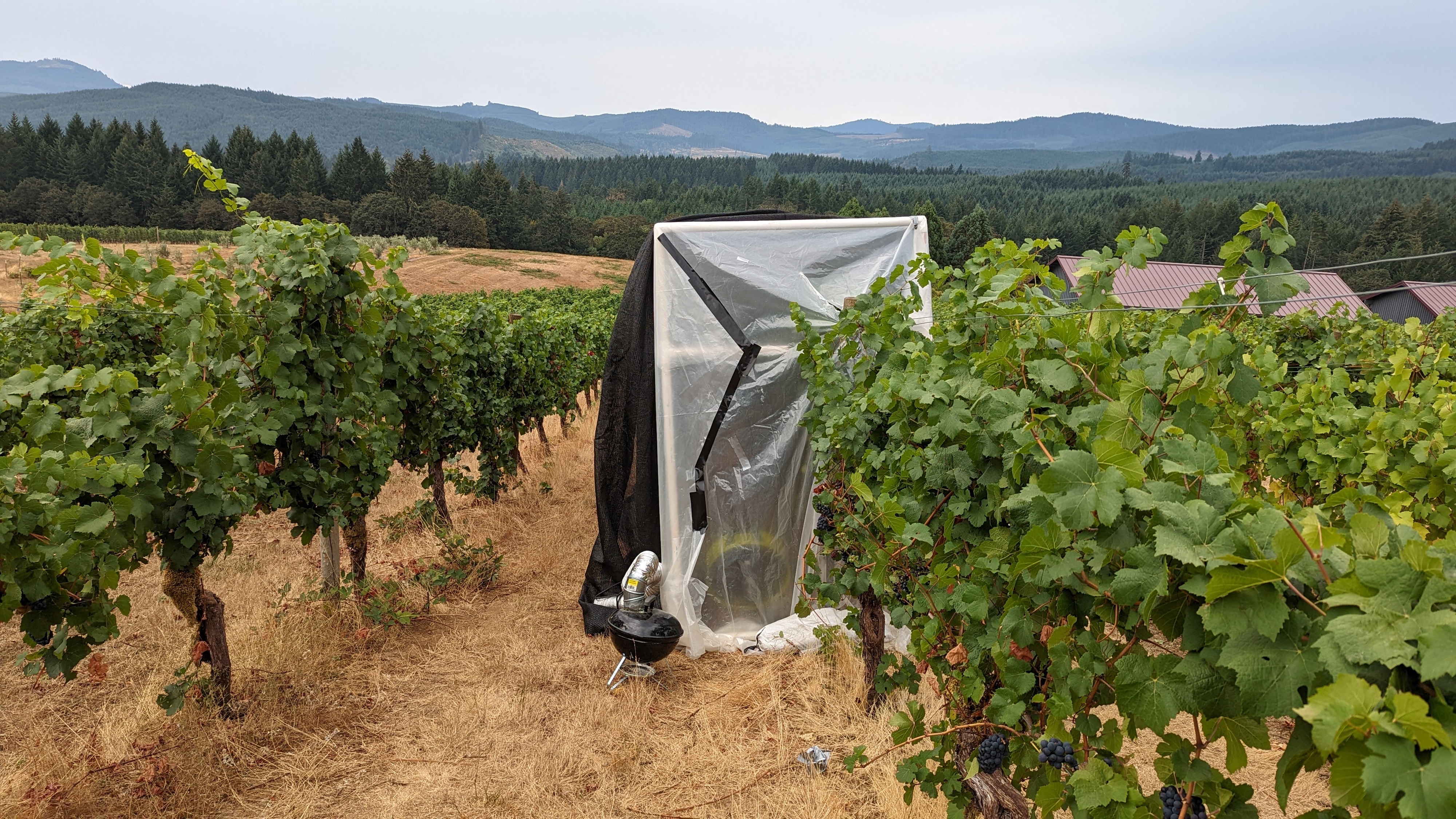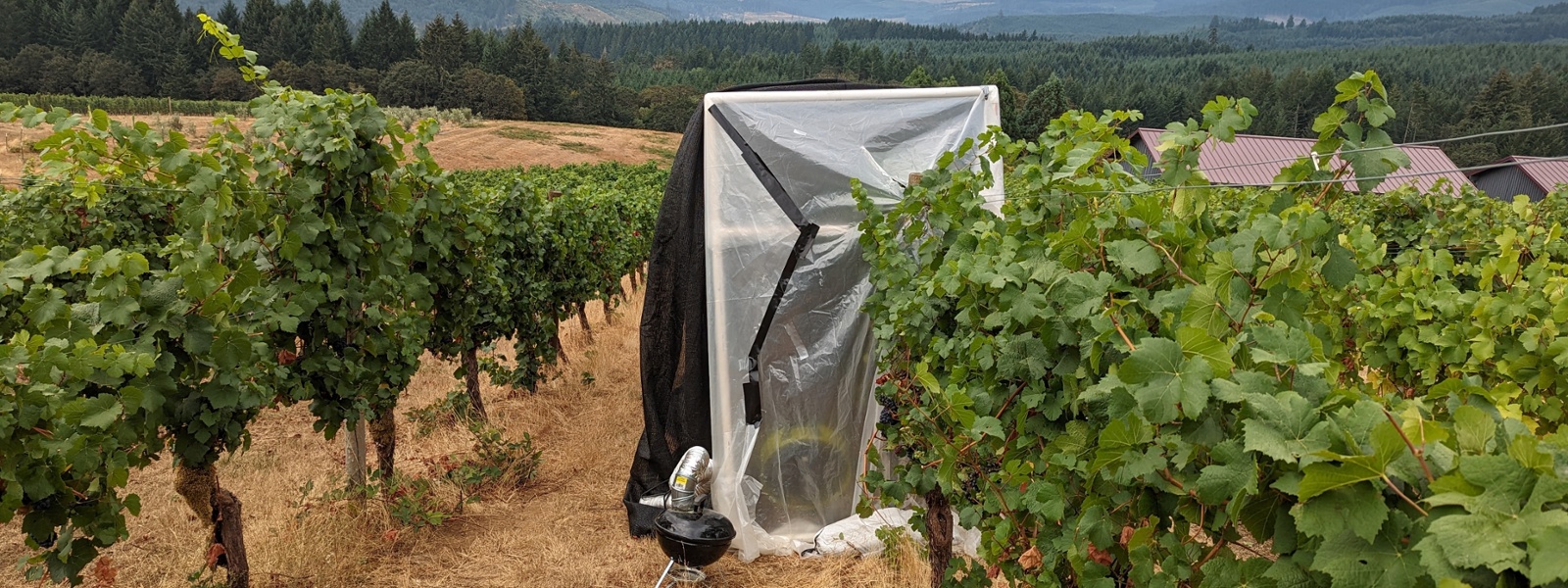Standards sought for testing smoke taint in vineyards

Wine grapes are exposed to targeted smoke as part of smoke-taint study at Oregon State University.
Photo/SeanNealon/Oregon State University

By Caleb Hampton
In 2020, Lake County winegrape grower Dave Rosenthal had nearly made it to harvest when wildfires swept through the region, blanketing his vines in smoke. The flames never reached Rosenthal’s vineyard. But the winery that had bought up two-thirds of his grapes rejected them, saying smoke had left them unfit for wine.
Rosenthal wasn’t alone. In 2020, up to 325,000 tons of winegrapes, worth hundreds of millions of dollars, went unharvested in California due to actual or potential smoke damage. The overall economic toll of wildfires on the state’s wine sector that year reached $3.7 billion, according to a study by the California Wine Institute.
As climate change and wildfires challenge California’s wine sector, smoke taint has emerged as one of the primary threats to the state’s most lucrative crop.
Despite a growing body of research on smoke taint, scientists and growers say gaps in the still-evolving science mean wildfire smoke continues to cause unnecessary crop losses and financial damage even when it doesn’t taint grapes.
“Smoke exposure and smoke taint are two very different things,” said Jeff Bitter, a Fresno County winegrape grower and president of Allied Grape Growers, a grower-owned marketing group.
But that difference can be hard to identify. Unlike other variables that impact winegrape quality, such as pests, disease or sugar levels, smoke taint is neither visible to the eye nor noticeable to the palate before the grapes are made into wine.
To detect smoke taint—or rather, to predict for it—wineries send grape samples to laboratories to be tested for a class of chemical compounds, called volatile phenols, whose presence in winegrapes is correlated with ashy-tasting wine. But the compounds are imperfect predictors.
“You can measure these different chemical compounds, but you don’t know how it’s going to show up in the wine,” said Rosenthal, the Lake County grower, who also works as a winemaker for Yokayo Wine Company.
Elizabeth Tomasino, associate professor of enology at Oregon State University, has spent years researching smoke taint.
“Much of the smoke taint mitigation work to date has not been overly successful and now we know because we have been looking at the wrong thing,” she said last year after her research team made a breakthrough discovery.
Tomasino and other researchers are working to create specific standards for diagnosing smoke taint in different varieties of winegrapes. “Those are going to be really important for the industry,” she said.
The lack of standardized testing levels for smoke taint has ramifications across the sector, impacting crop insurance policies and contracts between growers and wineries.
“I’ve seen contracts that are very generic,” Tomasino said, referring to language that mentions only “smoke exposure” and does not include specific compound levels in grapes. “That’s where you can get some disagreement between people who may have had good relationships beforehand.”
In 2020, two buyers accepted Rosenthal’s grapes. But a third, to whom he was selling most of his crop, rejected them. “When the winery did their tests, most of the compounds were fine, and one was high, so they rejected the grapes,” he said.
Rosenthal decided to harvest his grapes anyway, paying out of pocket to process them. When he did, “the wine did not show any smoke taint issues in the aromas or flavors,” he said.
Rosenthal suspects that smoke taint was not the only reason, or even the primary reason, his grapes were rejected. “It’s a winery that is oversupplied,” he said. “Any excuse to not take grapes, they jump at it.”
Among growers, it is accepted that quality markers come under closer inspection when wineries have surplus inventory.
“The presence of smoke in vineyards is more highly scrutinized and evaluated when the market is long,” Bitter said. “That doesn’t make all buyers bad. It’s just the reality of any market when you don’t have demand for something and you have the opportunity to get out of buying it.”
In other words, it often makes business sense for wineries to reject grapes, and due to the lack of specific smoke taint standards, Bitter said, “the contracts allow [them] to do that.”
At the same time, federal crop insurance policies have set a low bar for winegrape growers to file claims based on smoke taint losses. “That has given wineries the ability to feel a little more comfortable about rejecting grapes that have been exposed to smoke,” he said.
But such rejections can still be costly for growers. “If you don’t have crop insurance, which I didn’t, you can either leave the grapes on the vine and lose your crop or you can take a risk,” Rosenthal said, and pay to “custom crush them and have them turned into wine and then try to sell it.”
While Rosenthal’s wine came out untainted, he struggled to sell it, taking about a 70% loss. “Because so much of the state was impacted, many people were leery of buying any bulk wine from 2020,” he said.
Rosenthal doesn’t blame the wineries. As a grower and winemaker, “I can see both sides,” he said. “If I’m contracted for grapes, I don’t want to have to take them if they’re going to make bad wine.”
For everyone’s benefit, Rosenthal said, “I just wish there was a better predictor of how the wine will turn out.”
That’s what Tomasino and other researchers are working towards. Last year, her research team at Oregon State discovered a new class of compounds, called thiophenols, are markers for smoke taint.
“This changes the game as these new compounds are a completely different class of compounds than we were previously studying,” she said. “We should be much more successful over the next year or two in providing mitigation strategies for the industry that are actually effective.”
There are still challenges. Thiophenols are much harder to test for than the volatile phenols typically used in smoke taint analysis. According to Tomasino, only a handful of labs in the world are equipped to test for them, and doing so is expensive and time-consuming.
Growers say further research is critical. In June, U.S. Senators Alex Padilla, D-California, and Jeff Merkley, D-Oregon, introduced the Smoke Exposure Research Act, which would commit $32.5 million over five years to smoke taint research.
“Ultimately, where the research and this funding is going is to determine really accurate predictors for the industry,” Tomasino said. “We want to find something that is accurate but quick.”
Researchers are also exploring ways to test entire vineyard blocks for smoke taint without having to sample any grapes. “We measure the air quality for different parameters,” she said. That way, growers “don’t need to put any extra effort into that vineyard block,” she added.
In addition to improving testing and analysis for smoke taint, researchers are studying ways to completely remove smoke taint compounds during the winemaking process without compromising other aspects of the flavor. “Eventually, that will probably be possible,” Tomasino said, “but it’s very tricky to do.”
(Caleb Hampton is an assistant editor of Ag Alert. He may be contacted at champton@cfbf.com.)




